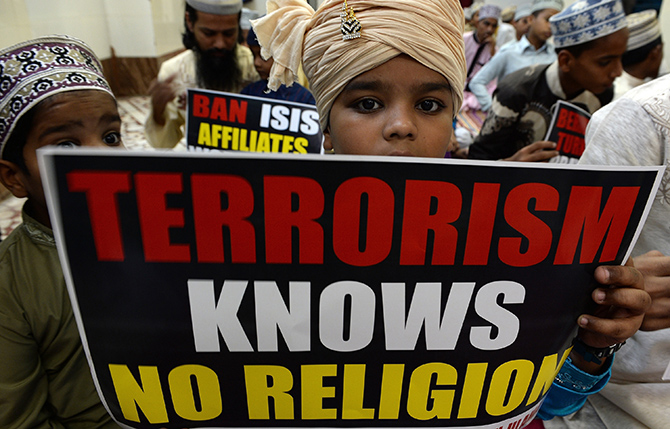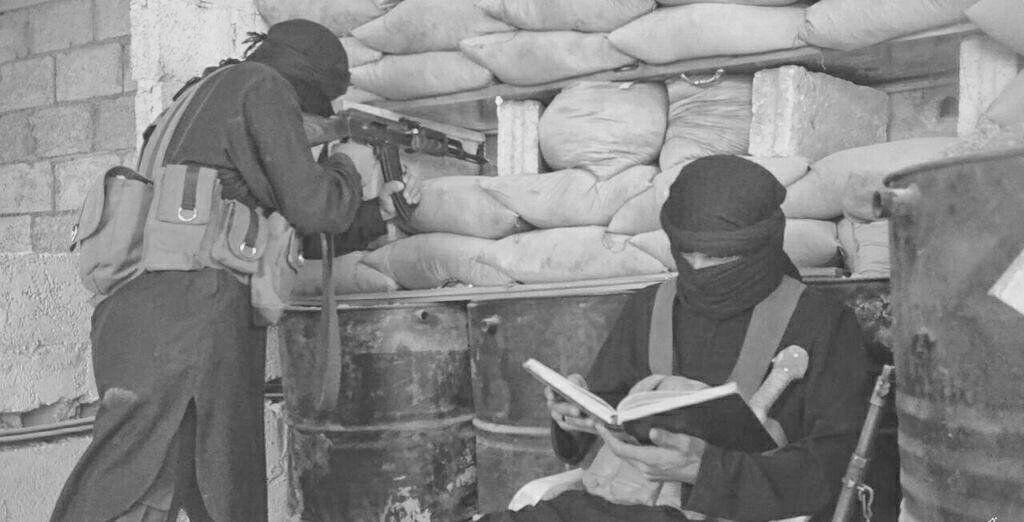It is understandable that many Muslims react by declaring that “IS-Islam” is “un-Islamic” and alien to their religion. However, since IS and other jihadi propaganda does not target persons who are firmly anchored in an alternate understanding of their faith, and does actually tap into significant elements of Islamic heritage, the aforementioned “denial response” may be viewed as that of believers who do not recognize, or do not wish to recognize, the religion they profess when confronted with the brutal crimes committed by terrorists in the name of Islam, and thus refuse to acknowledge the terrorists’ thoughts and actions as religiously based.
Whatever motivates this reaction on the part of mainstream Muslims, and their counterparts in the West, this denial response will not solve the problem we face, nor destroy the religious appeal of jihadi Islam. Turning again to Terry Eagleton, the critique of ideology he describes may also be relevant to the theology of violence, indicating that we must acknowledge and address, rather than ignore, the religious elements thereof:
[O]nly those interventions will work which make sense to the mystified subject itself. … “Critique” is that form of discourse which seeks to inhabit the experience of the subject from inside, in order to elicit those “valid” features of that experience which point beyond the subject’s present condition (Eagleton 1991: XIV).
But now we must turn to theology and religion, leaving ideology aside.
Religion
In this section, we will turn away from discussing whether “ideology” is an accurate term to describe the phenomenon in question, and instead focus upon religion as a concept that may be useful to understand what is frequently and somewhat awkwardly described as “religiously-motivated terrorism,” in order to avoid eliciting a negative response from believers. As history clearly proves, violence is a contingent possibility in religion(s). Acknowledging this fact, and possibility, does not constitute an insult to or “defamation of” religion. Rather, it is a necessary step if we are to understand, identify, marginalize and ultimately defeat those who advocate violence. By acknowledging the contingency of a violent turn, the possibility of religious adherents embracing nonviolence is acknowledged as well.
Religion only exists through believers “doing,” or practicing, religion. Alternative, nonviolent ways of practicing religion are what is needed, and not merely for Islam.
Excluding religion from the picture, especially in the case of jihadi Islam, is an attempt to reproduce the constellation of politics and religion in European modernity on a theoretical level, and apply this to the Muslim world. Such an attempt fails to take into account that the configuration of politics and religion may differ in other regions of the world outside of Western Europe. It also fails to take into account that what may be true at the level of governmental affairs in Europe, and to some extent within the framework of European theoretical/academic discussion, may not hold true at the grassroots level of Western societies themselves. Hence, the surprising “revival” of religion since the 1970s has occurred more in the realm of academic discussion than objective reality, as millions of people stubbornly refused to conform to the “decline of religion” paradigm.
Researchers in the field of new Islamic movements talk about the emergence of religious subcultures as the foundation of a lifestyle motivated by a certain religious ethos (Riesebrodt 2004: 27). Following James W Jones, we might say that the mingling of religion and politics in religiously motivated terrorism (and not only in jihadism) is one of the foremost challenges of the 21st century. The divine master plan claimed by these subcultures and movements gives them the mandate to act against societies at large (Lohlker 2012: 130).
As Jones expresses it: “The issues of national liberation, resisting domination, and economic justice are often intertwined with and sacralized by religious and spiritual motivations that cannot be ignored if contemporary terrorism is to be understood” (Jones 2008: 28). In other words: switching from religious language advocating violence to violent action depends on recoding conflicts in a religious language enabling the believers to perceive themselves as threatened by satanic forces, by apocalyptic powers, by Babylon, etc., and thus legitimizing violent resistance and changing the way these conflicts will go on. It depends on specific situations, but religious language and symbolism advocating violence is necessary for the process of recoding (Kippenberg 2010; cf.Lohlker 2012: 131).

Coding or recoding conflicts in terms of religion leads to the practical logic (Bourdieu) of the actors thinking and acting in religious terms, even if this may occur in the most superficial forms thereof. To claim that the true cause or motivation for their actions is political, economic, psychological, criminal and so forth privileges academic-theoretical epistemology while ignoring the practical logic of religious actors themselves. To the extent that governments and civil society wish to intervene in the process of “violent radicalization” and thereby prevent acts of terror, it is necessary to assess the share and form (ie, role) of religion in each individual case, in order to determine the most effective means of intervention. This requires careful analysis of, and response to, religious elements, as is obvious from the Arabic text of IS propaganda:
We will create supporters within your homes.
We will turn your sons into mujahidin.
We will raise them according to the Sunna of the Prophet Muhammad, the trustworthy.
We will revive in their hearts
honor, moral elevation, pride.
This is a hybrid use of a visual language that is easy to understand: the threat to parents; the reference to military jihad (in the context of IS, the most important religious duty); the reference to the Sunna (example) of the Prophet Muhammad, which serves as the religious foundation of IS; and the psychological element of reclaiming honor and moral superiority vis-à-vis one’s enemies, and thus overcoming feelings of inferiority (Lohlker 2016c). Eliminating religious references from this illustration, or any analysis thereof, by ignoring their existence, would neuter its effectiveness for IS recruitment purposes, and render it impossible for Western analysts to grasp the profound emotional and psychological power of IS propaganda and, hence, the precise nature of its threat.
The text in the following illustration reads:
O, God! This religion is Your religion, and we are Your warriors. We fight in Your path. O God! Our victory depends upon Your grace, favor and kindness. Their polytheism will not defeat our monotheism. Our disobedience will not vanquish their unbelief. O, God! Forgive us our sins. We seek Your forgiveness and turn to You in repentance. We believe in You and trust in You. Do not blame us for what the shameless are making of us. Bless, o God, our Prophet Muhammad, his family and his companions. Our final prayer is that all praise may be for God alone, Lord of all the worlds.
This text is deeply imbued with religious emotion and hostility toward everyone who is outside “the community of believers.” The message conveyed by the text, whose concluding prayer is derived from al-Fatihah, the very first chapter of the Koran, known to all Muslims, is reinforced by visual elements: one fighter stands guard while another presumably reads the Koran, with the Islamic State flag dominating the landscape. Again, we see violence and religion closely interwoven, for the combination of the “warrior-Islamic scholar” has become an integral part of IS iconography.
We may cite many examples in which conflict has been recoded in religious language and symbols (Kippenberg), without saying which came first: religion or conflict. In the present case, we may assume that the practical logic of jihadi actors allows for just one code: religious violence.

This (re-)coding may be very simple:
“You will not enjoy peace unless and until we ourselves truly live in peace, in the lands of Muslims.”
The above example shows a contextualization of the November 2015 terrorist attacks in Paris, with bombings conducted by French airplanes in Syria appearing in the bottom-left corner. The text and images are intended to evoke antagonism between Muslims and non-Muslims, employing religion as a “code” to interpret what IS perceives and depicts as a conflict between two states.
One simple fact needs to be emphasized at this point, in order to avoid a misconception that often results from the innate human tendency to think in terms of antitheses. Acknowledging and even stressing the importance of religion to contemporary jihadism does not imply that religion is the sole reason for the existence of jihadism, or any other form of religiously motivated terrorism. Jihadism is, in fact, a multi-determined, multi-factorial phenomenon. The misconception referenced above leads many otherwise rational people, including Western policy makers, analysts, scholars and journalists, to deny the importance of religion in contemporary jihadism.
Misconceptions regarding jihadi Islam
In a recent book, “Jihad and the Nihilism of the West” (Manemann 2016), we read that relating Islam to jihadism means to assume a causality between religion and violence and, especially, between Islam and violence (ibid.: 20). Shortly thereafter, the author acknowledges that Islam does in fact contain a set of symbols and ideas that are at times employed to legitimize violent conflict (ibid.: 21). The author then turns to his counterargument, by referencing the undeniable fact that for some Europeans who have become jihadists, religion was not the central element in the process of their radicalization and inducement to commit violence.
Specifically, Manemann is referring to several widely publicized cases that demonstrate that the jihadists in question may indeed have had only a superficial knowledge of Islam. This leads Manemann to erroneously conclude that IS-Islam cannot be the cause of these Europeans’ radicalization.
This often-voiced opinion ignores the fact that certain parts of the Internet have been heavily impregnated by jihadi propaganda, which does not consist of detailed theoretical-theological discourse, but rather assumes the form of a highly compact, religious symbol- and slogan-waving (IS-Islam) Islam, which facilitates the verbal and visual articulation of diverse grievances, while mobilizing opposition to those perceived to be responsible. IS propaganda sharply condemns the double standards of “Western” politics; the persecution of Muslims; the history of conflict between Islam and the West, ranging from the Crusades and colonialism to present-day bombings in Iraq and Syria that result in civilian casualties; systematic discrimination against Muslims (defined as a group targeted for religious reasons); and the creation of an ideal state based on (IS-Islam) Islam. This propaganda is embedded within a larger structure that intertwines with theological doctrine, religious motivations and individual, social and broader political feelings of malaise (Löwenthal 1990).
To claim that converts are acting in a manner that violates certain rules of Islam – with Islam itself portrayed as a noncontradictory system of thought – implicitly argues that only a religiously “well-educated” and “sufficiently knowledgeable” believer may be legitimately regarded as a representative of his or her faith. Such lines of discourse also imply that a recent convert cannot be termed a “true” believer. Certainly we are exaggerating the arguments in question. Yet, this exaggeration may serve to highlight the absurdity of such modes of reasoning. Setting benchmarks for accepting or viewing any given individual as a religious believer – and expecting believers to act in accordance with one specific mode of normative behavior – would consequently exclude the majority of religious believers throughout history.
The basic assumption made by those who deny jihadists’ religious motivation, or legitimacy, is that religion itself cannot be complex, ambiguous or contradictory, which is in fact a quite modern idea (cf, Bauer 2011, Ahmed 2016). The author does not state that Islam has no role in jihadism, but would prefer to argue against monocausal explanations of radicalization (Manemann 2016: 28). The author, however, does not offer a solution regarding how to approach the (in)compatibility of his claims: “Religion plays no role” and “religions play a role.” We would expect him to answer the question, “Which role?”

This conceptual unease is born out of a demarcation vis-à-vis other intellectual positions regarding jihadi Islam, which are characterized by different types of misconception, although they do display awareness of the importance of religion to jihadism. The first misconception is displayed by authors such as Graeme Wood (2015), who vigorously asserts that the barbaric variety of Islam practiced by the Islamic State is “medieval.” In fact, IS-Islam is a modern variety of religion, which emerges from and is an integral part of the dark side of modernity itself. And yet it is, in fact, a profoundly religious variety. To construct a distinction between an evil, brutal and thus inherently “medieval” religion, which, by definition, cannot be modern and enlightened, is to subscribe to the widespread normative misconception of modernity as a homogenous and altogether positive force. Yet the past two centuries bear witness to innumerable cruelties that were based upon, and the product of, modern rationality. Even the concept of enlightenment is much more problematic and difficult to understand than the, at best, naïve defenders of the term “enlightenment” may imagine. “Dialectic of Enlightenment,” by Theodor W Adorno and Max Horkheimer, seems to have been forgotten.
A second misconception (Wood 2015) is that IS represents an attempt to reconstitute the age and circumstances of the earliest Muslim community. Close scrutiny of the Arabic-language material produced by the Islamic State demonstrates that it is consciously engaged in a kind of archeological excavation of the Islamic tradition, from which diverse religious artifacts it is constructing IS-Islam.
The one-sided arguments referenced above are rooted in a flawed approach to jihadism and IS. Their shortcomings are partially due to a heavy reliance upon the few IS materials available in English and other European languages. To date, Western knowledge of the bulk of jihadi discourse, more than 80 percent of which occurs in Arabic, remains rudimentary at best, with the source material itself largely inaccessible and unexplored.
Reading their lips
Turning to jihadi Arabic language resources, we may find, for example, a blog entitled A'iddÅ«! (“Prepare yourself!”). This title refers to a Koranic imperative. The blog offers resources (primarily documents and videos) that enable jihadis to wage “the military jihad” at different levels. As such, it is predominantly a “jihadi military” blog.
The blog contains many files that provide detailed information regarding explosives, small arms, antitank weapons and intelligence operations, but also files that contain advice regarding the spiritual preparation of warriors. One file that discusses military tactics and the training of leaders also describes ‘AlÄ« ibn Abi TÄlib, the son-in-law of the Prophet Muhammad, and AbÅ« Dharr, a prominent companion of the Prophet, as role models for cautious behavior. Another file that discusses security issues provides illustrations from the biography of the Prophet. We can even access a special file on this blog that is focused primarily upon military lessons derived from the biography of the Prophet, while among other files we encounter the story of AbÅ« Mahjan al-ThaqafÄ«, another companion of the Prophet, who is cited as an example for those who have committed great sins and feel they are consequently forbidden to wage military jihad – quite the contrary, for sure.







%20resized.png)
